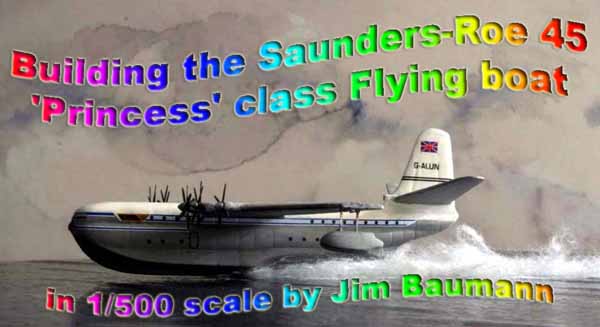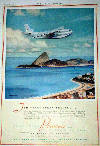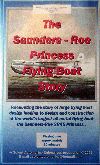 |
|||||||||||
| Way back in 1990 whilst sailing a Dragon class yacht off
Calshot Spit Southampton UK in the Solent we were ordered with hooters
and gesticulations by Smartly attired chaps in a very shiny high speed
launch to change course.... Somewhat aggrieved at having to sacrifice hard
won windward height ...I hollered back as to why I should... to which the
reply came in the form of a finger pointed skywards... following on the
direction of said finger we spied a mighty n4-engined civilian version
of a Sunderland flying boat coming in to land.... The sight of this roaring
and thundering behemoth alighting with the grace of a ballerina upon the
choppy waters of the Solent will stay with me forever ... and so my affection
for the flying boat was born....-- I since have always had a soft spot
for these anachronistic symbols of a by-gone age...
The end of the flying boat airline era came after the second world war.
The flying boats were designed because there were originally very few long
runways anywhere in the world that could handle a large aircraft . Navigation
aids of the time were minimal and bad weather often meant that planes had
to land with a cross-wind. The flying boat overcame all of these things
neatly with ready made water runways available all over the world.
In 1945 initial design work was carried out by the Isle of Wight ( UK) company Saunders Roe, when it was decided that the UK to America route would be best served by flying boats. This project carried on from the pre-war attempts made by Imperial Airways at crossing the Atlantic non-stop. The company began work on what was hoped to become the new airliner to cross the Atlantic flying from Southampton to New York. as before WW2 there were no concrete runways anywhere in the UK --Flying boats presented the obvious answer of infinite runway length After the war the world had a large amount of landplanes (ex bombers and transports) and lots of concrete runways on ex-military bases so it was natural that the airlines should restart airline services with the DC-3s, DC-4s and DC-6s that were to be purchased from the USAAF cheaply. Most post-war airlines restarted with the Douglas C-47 (DC-3) Dakota in this way. |
|||||||||||
| In May 1946, work began on Saunders-Roe's largest flying
boat, the Princess. She was a two decked, ten-engined(!!) flying boat,
designed to cruise at 395 mph , weighing 154 tons . The Saunders Roe Princess
was described as the finest flying boat ever built and a rival to the greatest
liners.
This advertisement from the Illustrated London news of 1949 was perhaps a little optimistic.... |
to enlarge |
||||||||||
 |
|||||||||||
| Three hulls were commissioned at great expense to the UK
taxpayer with costs rising in 1950 from the estimated £2.8 million
to £10 million. Two years later the first Princess flew and the sight
according to observers was an impressive one, she ran high and proud in
the water in front of a great cloud of spray. She was capable of virtually
all that had been asked of her. weighing 154 tons, and three were built.
She was designed to carry a maximum of 220 passengers, and on 22 August,
1952, she flew for the first time. She was supposed to merely undergo taxiing
trials that day, yet the test pilot took off after a very short run-up,
saying later, "'She wanted to fly, so I let her" ..... The Princess was
the largest flying boat ever made( with the exception of the Spruce Goose)
and it flew on numerous occasions, including the Farnborough air display
of 1952 where she drew much admiration with her graceful and powerful fly
past performance.
Despite the advanced fly-by-wire control technology on the aircraft
being ahead of its time, this wasn't seen as enough to persuade manufacture
and airlines decided not to order any. BOAC, the intended customer, did
not want them as its flying boat services had ended in 1950. Another problem
were the engines, which were not as efficient as they could be. It had
been hoped that Rolls Royce Tweed engines would be installed, but these
units were no longer available. The alternative Bristol Proteus engines
were not as powerful as advertised. Despite the engines' shortcomings,
the Princess was a practical aircraft. In 1958 the US Navy were considering
ordering the construction of a nuclear-powered version, but in 1959 decided
to cancel.
Despite the failure to sell the Princess, Saunders-Roe felt sufficiently encouraged by it to design two other similar aircraft, neither of which were built. The first, known as the Duchess, would have been smaller, jet powered with six engines, and would have carried 76 passengers at 500 mph. The other was an even larger version of the Princess, larger than any aircraft flying today(!!) . Known as the P192 project, it would have been 670 tons, have a wingspan of 313 feet and be 318 feet long It was designed in 1955 for P&O ferries, who were interested in the possibilities of flying cruise ships. Alas nothing further came of this. |
|||||||||||
| I purchased this limited edition 1/500 scale kit made by Piranha Models( France) from e-bay. It is made of a Pewter type metal, contained a very neat decal sheet and a small photoetched fret . |  |
||||||||||
| The actual construction was not terribly challenging other
than filing and sanding seams. Decalling was done on the completed and
painted model over a couple of brushed coats of Future polish.
I mounted the hull just kissing the water as she becomes airborne on artists watercolor paper. Its relatively small size even in 1/500 can be seen when compared to a pencil and film cartridge I spent many happy hours watching and re-watching the essential video reference work of the SARO 45 |
 |
||||||||||
 |
|||||||||||
|
|||||||||||
All in all a most amusing and enjoyable
brief diversion from the serious business of building model ships!!
|
|||||||||||







